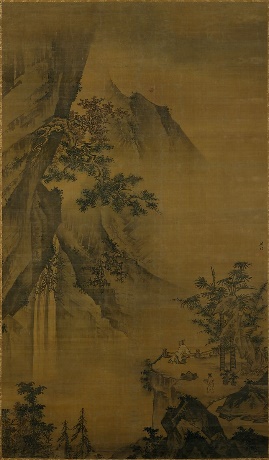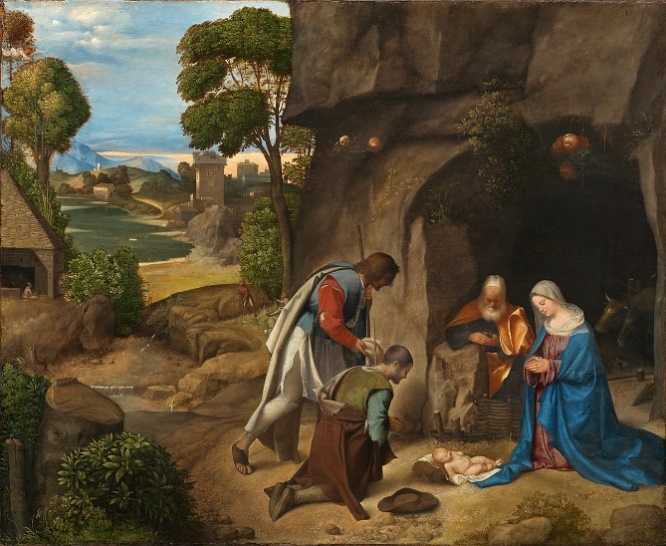Eastern, specifically Chinese and Japanese, and western art cultures significantly differ, portraying the world differently through paintings. While Western artists depict the world from a central viewpoint and focus on the most important objects in a scene, Chinese artists in their paintings primarily focus on background detail. Such comparison will be demonstrated through analysis of late 15th century Zhong Li painting “Scholar viewing a waterfall” and Giorgione’s “The Adoration of the Shepherds.” The essay will compare these two paintings in terms of different perceptions of space, artists’ different attitudes, and the depiction of people in landscape art.
The landscape depiction in Eastern and Western cultures is radically different due to contrasting nature and values. The first noticeable detail in comparing Zhong Li’s and Giorgione’s work is their perception of space in art, representing typical trends of both cultures. Unlike Western painters who attempted to capture an exact depiction of a visual world, Chinese painters do not seem to have a definition of space as an observable geometrical object used to organize space and create specific spatial relationships (Bao et al).
Such difference can be seen in the paintings, where Giorgione depicts an accurate perspective of distance. He accurately depicts the distance and keeps realistic measures in his art. Geometric perspective was added to maintain the illusion of three-dimensionality by using a single-point or symmetric perspective. Thus, western painters sought to create an exact image of what they see or believe to see (Bao et al). On the contrary, Li’s art is spacious, not following the rules of geometry. Compared to Western painters, Chinese artists have used particular methods of stressing spatial details. Aside from the traditional vertical arrangement of spatial details, of which “Scholar viewing a waterfall” is a prominent example, a common way of implying distance was using a perspective.
Such difference may be connected to the Eastern people’s relation to nature, which is the next point. Eastern art demonstrates a complex framework for human interactions with nature, prominently depicted on the “Scholar viewing a waterfall.” The central dynamics show a strong bond between the painting figure and the setting. The harmony of a Scholar with nature is symbolized by his seated figure on the garden terrace, leaning back just like the lord of his realm to watch the powerful forces of nature as they conduct a special performance for him alone.
People depicted in “The Adoration of the Shepherds” are separated from nature and act as a distinct part of the painting. On the right, the painting’s main scene is set in front of a dark cave. Such a focused approach to people stands out compared to Eastern art, where the landscape is a secondary scene. The decision to put the kneeling shepherd pilgrims in the center of the painting creates genuine dramatic tension. The parents, child, and pilgrim form an anchored rectangle that serves as a counterpoint to the left’s receding landscape.
Both paintings represent certain attitudes and artists tried to convey, with some more vivid and others abstract and emotional. While taking examples of two contrasting paintings of Li and Giorgione, people may see the distinct tone and author’s message. Rather than just depicting the object’s details and exact appearance, as in Western art, Chinese landscape painters often embed their personal feelings and emotions into the painting (Bao et al). As a result, viewers will notice many white spaces and wide strokes in Zhong Li’s work, which reflect the emotion and deep concern for this piece.
In contrast, western paintings, such as “The Adoration of the Shepherds,” are influenced by the Christian religion. God is the maker of beauty and the universe in western art, and painters are often looking for traces of God’s existence in the naturalistic landscape’s details. As a result, western painters, including Giorgione, have often considered the expression of a realistic natural scene to be a kind of contribution to God, allowing people to come closer to their faith. Such depiction of nature is no longer prevalent in contemporary art, which has extended to have many different styles and ways of portraying landscape.
The geographical, cultural, and religious differences between the western and eastern worlds significantly impact the art, which results in such a distinct portrayal of the landscape. The Chinese history, and conservative civilization formed an individual style, which represented in the form of depicting nature as the primary and superior part of the art (Bao et al.). People only played secondary roles, which is demonstrated in Zhing Li’s work. Influenced by religions, advocating humility and Tolerance, eastern works, embody the syncretism of Zen and non-action consciousness, as in “Scholar viewing a waterfall”.
The rise of foreign trade and western proximity to the sea had a major effect on developing the artistic temperament, with paintings being more vivid and featuring several scenarios. Furthermore, the western people have conquered the spirit of ambition and resistance, promoting heroism and chivalry, and seeking realistic depictions of literature, such as “The Adoration of the Shepherds,” which contains a variety of religious figures.
Thus, as demonstrated in two distinct examples of Western and Eastern art, their landscape portrayal and art in general significantly differ from one another. The attitudes towards nature are entirely distinct, with Eastern painters glorifying it and Western creators focusing more on the people. Moreover, the messaging of artists is more vivid in eastern art, through more intimate landscape than realistic religious art of Western culture. Thus, it is rational to conclude that Eastern and Western philosophies concerning nature are vastly different; however, contemporary art fades the lines between these issues every year. Such difference is explained by different cultures, history, and geographical location of the art, which undoubtedly significantly influences the works.


References
Bao, Y., Yang, T., Lin, X., Fang, Y., Wang, Y., Pöppel, E., & Lei, Q. (2016). Aesthetic Preferences for Eastern and Western Traditional Visual Art: Identity Matters. Frontiers in Psychology, 7.